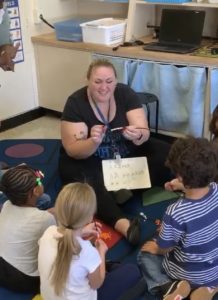 As the end of this most unusual of school years comes to a close, we want to recognize the educators who are vital partners in our mission of arts-integrated education. Teachers have experienced challenges they never could have dreamed of, as they were forced to leave their classrooms and teach students via video technology.
As the end of this most unusual of school years comes to a close, we want to recognize the educators who are vital partners in our mission of arts-integrated education. Teachers have experienced challenges they never could have dreamed of, as they were forced to leave their classrooms and teach students via video technology.
Special education teachers have had extra challenges in connecting with their students when they can’t see them in person. Anna Frassmann-Swadinsky is a program specialist for Norfolk schools, but she also works as a teacher of deaf and hard-of-hearing students at Mary Calcott Elementary School. Her caseload includes a first-grader who is profoundly deaf and two third-graders—one is profoundly deaf but has a cochlear implant that allows access to sound and another who is hard of hearing. Frassmann-Swadinsky offers her students a weekly Zoom check-in, where they may read stories or do math problems together. But the normal techniques she uses when she teaches her students face-to-face, such as tapping on a desk to get their attention, don’t work on video.
“For my students who are deaf and hard of hearing, the biggest challenge is being able to engage them through video chat technology when you don’t have the ability to physically redirect their attention.”
Like many other teachers, Frassmann-Swadinsky is concerned about her students in this distance-learning environment.
I miss knowing that they’re okay. I worry about their mental health and being isolated.”
“I have one student who doesn’t have any siblings so she’s the only little girl in her house and doesn’t have anyone else to play with. I really worry about her,” Frassmann-Swadinsky says. “I miss being able to actually teach. I’m so terrified of how much we will have lost and where we’re going to start when we finally return to in-person class.”
Despite the challenges, Frassmann-Swadinsky has praise for families who are trying to educate under difficult circumstances, mentioning one family whose home-schooling includes fun science experiments and trips to places like the Norfolk Botanical Gardens. Still, just about every parent now has a greater appreciation for their children’s classroom teachers. Teachers may not be risking their lives during this pandemic, but they’re showing up every day for their students and facing unique challenges.
Every teacher is trying to find a creative way to keep their students engaged and learning and to remind them that we’re still there for them.”
“The idea of calling ourselves essential workers almost sounds arrogant, even though when you look at it from an abstract perspective, we are essential,” Frassmann-Swadinsky says. “You almost feel bad about saying it—‘Oh I’m not a doctor, I’m not a nurse, I’m not on the front line.’ But I am essential, because there are millions of kids in the United States that need to learn.”
Arts for Learning wants to salute hardworking essential workers in our state in the way we know best—through art. Children can draw, write a story or poem, play music, dance, or use any other art form they choose as a way to say “thank you” to our essential workers. Click here for full details of how to enter our Artful Thanks contest!



